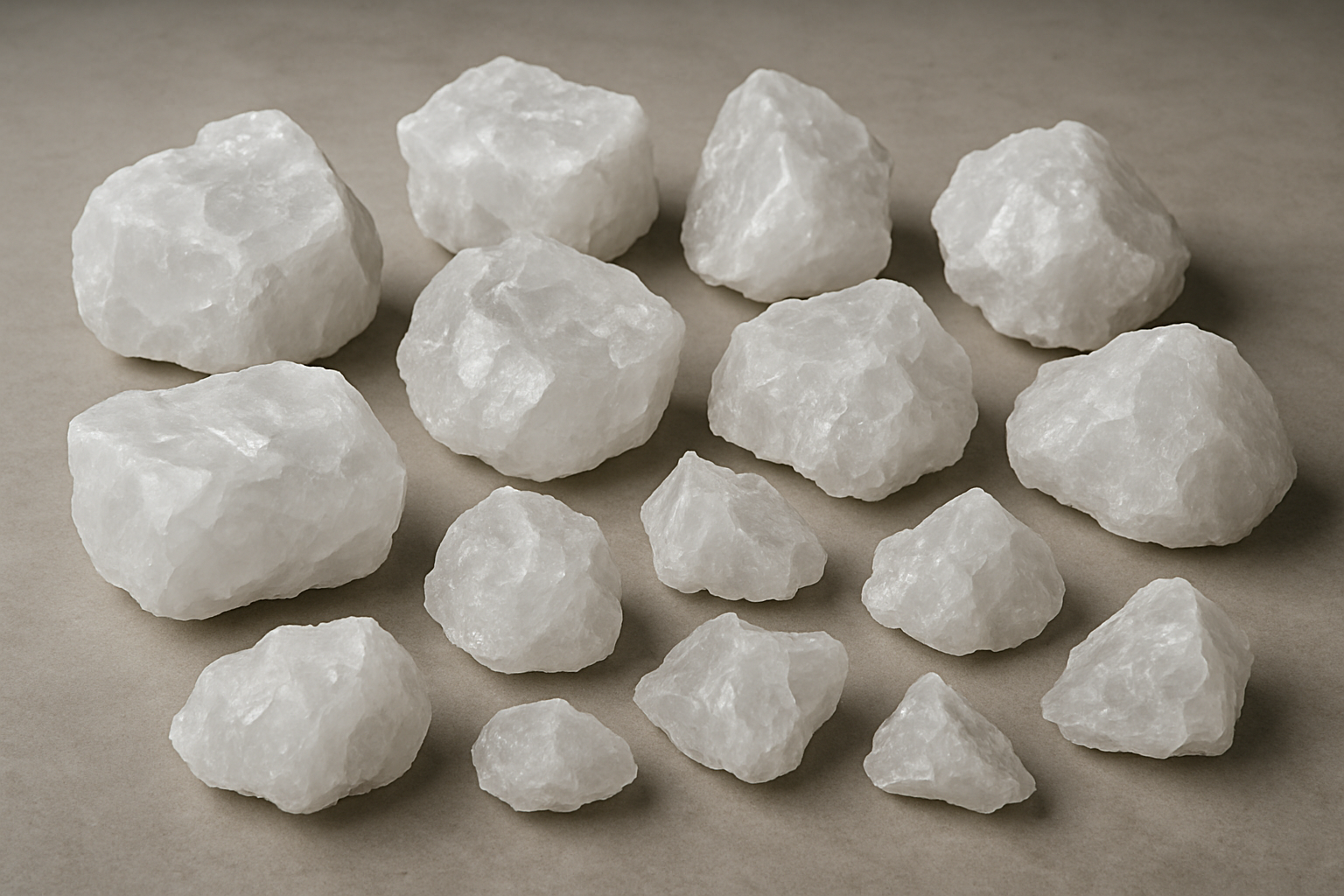Quartz:
Quartz, also known as mero, is one of the most common minerals in rock formation. It is characterised by a high degree of hardness, ranking seventh after minerals such as beryl, sapphire and diamond. Thanks to its unique properties, quartz is widely used in various industries such as electronics, glass, and ceramics, due to its chemical stability and exceptional hardness.

Specifications and physical characteristics:
› Quartz is characterised by a non-metallic glassy lustre.
› Its most popular colours are:
- White
- Transparent
- Grey
- Purple
- Yellow

Extraction and industrial processing:
We are committed to the highest quality standards at all stages of production, from the extraction and crushing of quartz ore, through grinding it into granules with precise specifications, to supplying it to local and global markets or using it in various industrial applications.
Extraction stage
Quartz is extracted through open-pit mining, followed by drying and precise sizing of the raw material, with the aim of producing a material that meets the requirements of various industrial applications.
Crushing stage
The crushing process begins with manual sorting or colour sorting, followed by crushing the ore into small pieces, then fine crushing to prepare it for the grinding stage.
Processing stage
The ore is purified through a series of processes including: ore washing, magnetic separation, flotation, and acid leaching, to ensure the highest possible purity suitable for industrial use.
Phosphate uses
Quartz sand is known for its high strength and extreme resistance to crushing, making it an essential component in oil and gas extraction processes. During hydraulic fracturing, this sand is pumped deep into wells under enormous pressure to break up the host rock. Once the fractures occur, the sand grains seep into them and keep them open even after the pressure drops, allowing natural gas or oil to flow more easily towards the surface of the well.
Laboratory crucibles are used as primary containers for holding chemicals during thermal experiments or chemical reactions. Quartz is an ideal material for manufacturing these crucibles due to its unique properties, such as:
- Very high melting point
- Chemical inertness
- Low thermal expansion
- Excellent resistance to thermal shock
- Superior dimensional stability even under high temperatures
These properties make quartz crucibles the ideal choice for laboratory environments that require precision and safety when handling high-temperature materials or sensitive reactions.
Quartz sand is known for its high strength and extreme resistance to crushing, making it an essential component in oil and gas extraction processes. During hydraulic fracturing, this sand is pumped deep into wells under tremendous pressure to fracture the host rock. Once the fractures occur, the sand grains seep into them and keep them open even after the pressure drops, allowing natural gas or oil to flow more easily towards the surface of the well.
For centuries, quartz has been an essential stone in the jewellery and gemstone industry, thanks to its high hardness, crystalline structure, polishability and superior durability, making it ideal for decorative use.
Many of its famous varieties are used as gemstones, such as:
- Amethyst
- Citrine
- Ametrine
- Rose Quartz
- Aventurine
- Opal
Quartz is also used in its microcrystalline form, known as cryptocrystalline, such as agate and jasper, which are popular gemstones in unique designs.
Quartz crystals are vital components in modern electronics manufacturing due to their ability to generate an electric current when subjected to pressure or bending, a property known as piezoelectricity.
This feature is used to generate accurate and stable frequencies, making quartz an essential component in:
- Wireless transmitters
- Radio receivers
- GPS systems
- Computers
Thanks to its accuracy and stability, quartz helps improve the performance of these devices and ensure their reliability.
Quartz sand is commonly used in metal casting, where it is mixed with binding materials such as clay, sodium silicate, and oil-based resins to form strong moulds.
Its properties, such as high melting point and excellent mechanical strength, contribute to its ability to withstand harsh casting conditions.
Grisovolfine quartz is also used to smooth rough edges and lines resulting from cutting, drilling, or casting.
In addition, quartz sand is added to molten metals during the process of removing impurities (especially oxygen), where it acts as a medium to capture and easily dispose of them.
Synthetic quartz crystals are produced in lab by dissolving silicon dioxide (SiO₂) in an alkaline aqueous solution at high temperatures.
Even though it's a long process, it makes crystals that are super pure and high quality, with properties close to natural crystals.
These crystals are highly resistant to acids, corrosion, high temperatures, shocks, bending and pressure, making them ideal for use in electronics, semiconductors, solar energy, optical discs and printing equipment.

